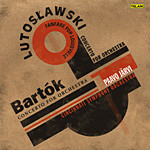
Concerto for Orchestra (with Lutoslawski's Fanfare for Louisville. )
 $41.00
Out of Stock
$41.00
Out of Stock6+ weeks add to cart
BARTOK
Concerto for Orchestra (with Lutoslawski's Fanfare for Louisville. )
Cincinnati Symphony Orchestra / Paavo Jarvi
[ Telarc SACD / SACD ]
Release Date: Saturday 1 April 2006
This item is currently out of stock. It may take 6 or more weeks to obtain from when you place your order as this is a specialist product.
"A release I will revisit occasionally if the mood takes me, the Lutosławski more successful than the Bartók"
(MusicWeb Sept 2006)
Hybrid multi-channel SACD playable on all Compact Disc players
"A release I will revisit occasionally if the mood takes me, the Lutosławski more successful than the Bartók"
(MusicWeb Sept 2006)
Paavo Järvi and the Cincinnati Symphony Orchestra make their ninth Telarc recording with Concertos for Orchestra by both Béla Bartók and Witold Lutoslawski, as well as Lutoslawski's "Fanfare for Louisville.”
Järvi himself poses a very simple but significant question regarding the two mid-20th century composers: "Is it possible that two works can share so much in common purely by accident? Whether or not Bartók's Concerto for Orchestra directly influenced Lutos⊃awski's, we can sense the musical affinity between these great Central European composers in the folk melodies and chorales at the center of both masterpieces. Hearing them together on one recording gives the listener the joy of making these connections.”
Bartók and Lutos⊃awski composed their concertos for orchestra at opposite ends of one of the twentieth century's most defining events, World War II. "Yet from separate standpoints—Bartók's during his last years as an emigrant to the United States and Lutos⊃awski's during this years of struggle in post-war Poland—the pieces share distinct similarities,” according to the recording liner notes by Jonathan D. Kramer and Eric Dudley. "Both works display their composers' interests in earlier music and formal ideas, their connection to the folk music of their native lands, and their response to the circumstances of their times—and both are towering examples of the concerto for orchestra as a genre and among both composers' most popular works.”
After Bartók had moved his family to the United States, he started to experience severe health and financial problems. He had developed international ties through connections like fellow Hungarian Fritz Reiner, who was the music director of the Cincinnati Symphony Orchestra. Aware of the composer's predicament, Reiner and violinist Joseph Szigeti approached Serge Koussevitsky, the music director of the Boston Symphony Orchestra, to organize a commission for Bartók. Once Bartók's health began to improve, he completed the Concerto for Orchestra in 1943.
Bartók explained the work's title by its "tendency to treat single orchestral instruments in a concertante or soloistic manner.” Its five movements are cast in an arch form, with substantial outer ones flanking two scherzos and a slow movement at the center.
The political situation in his country, Poland, is a strong part of Lutoslawski's Concerto for Orchestra. The post-war years were a time of repression in Poland under Stalin's rule, and in 1949 the vice-minister of culture organized a conference instructing new guidelines for Socialist content in art. Lutoslawski muted his protest in order to survive.
The three-movement work is broken down into an Intrada (Introduction) in arch form. The second, Capriccio, is a scherzo with a trio (Arioso). The third and longest movement begins with a passacaglia on a folk theme that rises in seventeen repetitions from low to high. The main body of the movement is the Toccata, interrupted by a chorale that appears softly at first and then climatically near the end.
Much like Bartók's Concerto, Lutoslawski's Fanfare for Louisville emerged from the composer's relationship with an American orchestra, The Louisville Orchestra. Upon winning the Grawemeyer Award in 1985, Lutoslawski conducted a series of performances of his Third Symphony in Louisville. Months later, he sent the orchestra the Fanfare as a gesture of thanks.
This new recording by Järvi and the Cincinnati Symphony Orchestra comes on the heels of their critically acclaimed recording of Dvoøák: Symphony No. 9 and Martinù: Symphony. No. 2, which was picked as an Editor's Choice by Gramophone. The reviewer at the international publication proclaimed, "Paavo Järvi reveals his keen imagination and sharp concentration in both performances and under his guidance, the Cincinnati Symphony Orchestra is consistently excellent: this ensemble more than matches that of the rival versions.”
Järvi explains what he aims to accomplish through his Telarc recordings: "My Cincinnati Symphony Orchestra recordings with Telarc allow listeners to hear works in a new light. Pairing standard repertoire with rarely heard or newer works creates interesting connections, and I like that a lot.”
Tracks:
Lutoslawski:
Concerto for Orchestra
Bartok:
Concerto for Orchestra
